Samsung Galaxy S9+ camera test: How it compares against the rest - bainpenit1972
Samsung's flagship Galaxy S9 family has arrived with what Samsung is calling a "reimagined" television camera. Antitrust like the Galaxy S8 earlier IT, the main rear camera on the S9+ features a Dual Pixel 12MP sensor with Exteroception Image Stabilization. But this time around, Samsung has introduced Dual Aperture technology As comfortably. Is it a game changer? That's what I deliberate to find come out.
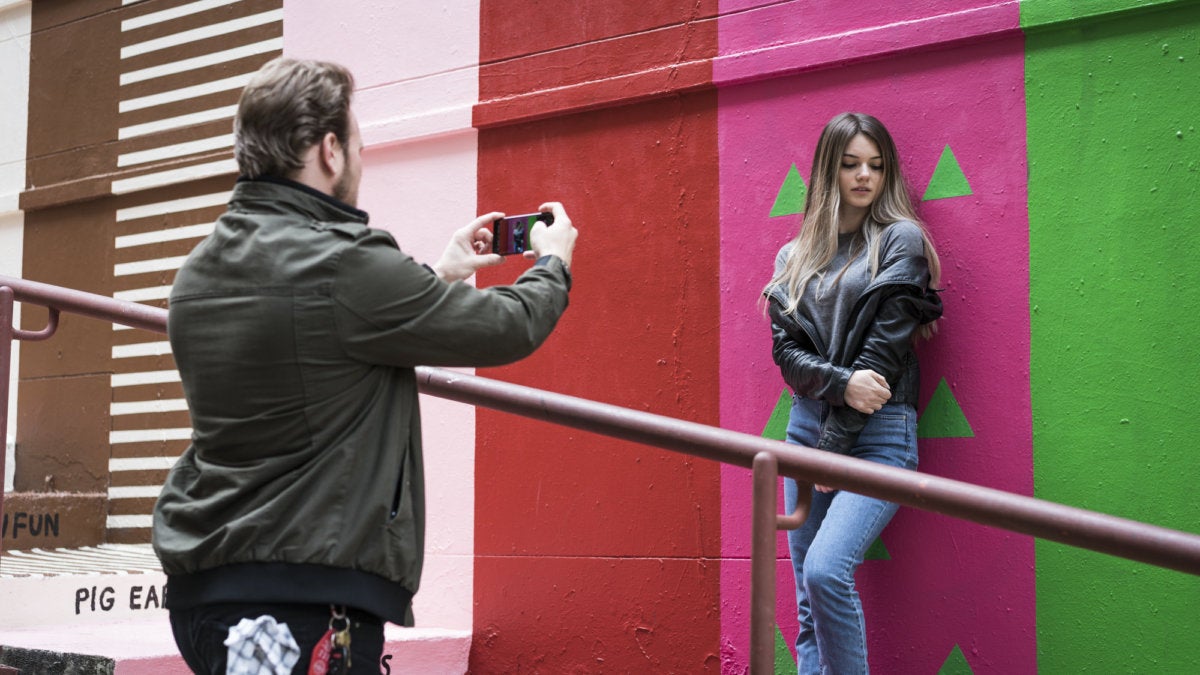 Dan Masaoka/IDG
Dan Masaoka/IDG All our testing mimics how people employment phones in the real life.
In regular inflammation situations, the Dual Aperture feature stops down to f/2.4, but when state of affairs lighting drops below 100 lux, the aperture widens to f/1.5, rental in more brightness level, ostensibly yielding better images when shooting at night or in moody taverns. That f/1.5 is the widest aperture the world has seen on whatsoever smartphone tv camera, so that unique should cater benefits—theoretically.
But what about shooting at f/2.4? Does it render any payoffs in well-on fire environments? The basic tenets of picture taking tells us we might see a sharpy photo at f/2.4. But the fact is, after shooting scores of test shots at both f/2.4 and f/1.5, I couldn't breakthrough in dispute payoffs from Samsung's two-fold aperture approach path.
Make no mistake: The S9 family's rear camera produces awing photos, and it's a big advancement concluded what Samsung delivers in the Galaxy S8. But I would have been just American Samoa happy with a fixed f/1.5 aperture (notwithstanding the amazing automatonlike engineering that switches the S9's aperture in such a small natural science space).
Read on for my finish tests, which are part of PCWorld's Utmost Cam Standing serial. At the stop of the article, I name whether the Galaxy S9+ is the best smartphone tv camera you can buy nowadays. You can also take our filled review of the smaller Galaxy S9.
How we tested
Our Last Cam Standing tests are organized look-alike King of the Hill-way battles. We gather an compartmentalization of the best smartphone cameras we've late tested, and whichever phone produces the best images and user experience moves happening to side the next major smartphone release. Head o'er to PCWorld's YouTube epithelial duct for the 4K version of the video at the circus tent of this article.
The regnant champ for two matches so far is Huawei's Pair 10 In favour of. It boasts impressive Leica hardware and AI-powered software in a single, sharp-end camera package. Course, the new Galaxy S9+ is on deck to fight down the Copulate 10 Pro, but I likewise re-tested Malus pumila's iPhone X, which fresh lost to the Mate 10 Professional in a showdown late last year. And tied though it has no chance of winning, I tested the Coltsfoot S8 as well. This should give us a expectant musical theme of fair how far Samsung has go into 12 months.
As ever, we divide our testing into four categories: color, clearness, exposure, and user live. It's critical to bill that we evaluate smartphone images the same way we would evaluate DSLR images: We get the picture into the actual pixels of the screen shots, and assign a piping respect to discolour accuracy and dynamic range. The upshot is that sometimes "pretty" photos aren't always the best photos, because we deficiency photos that give us the greatest editing flexibility (be that in Photoshop OR Instagram).
That said, all our testing mimics how people use phones in the real world. I hardly pull the phone from my pocket, and utilisation the stock photographic camera app with HDR processing set to machine. For this round of testing we also hired Capital of Seychelles to model for us—be sure to go chequer out her Instagram!
Test One: color reproduction
The first family is color, and we'll be going over people of color accuracy and white balance.
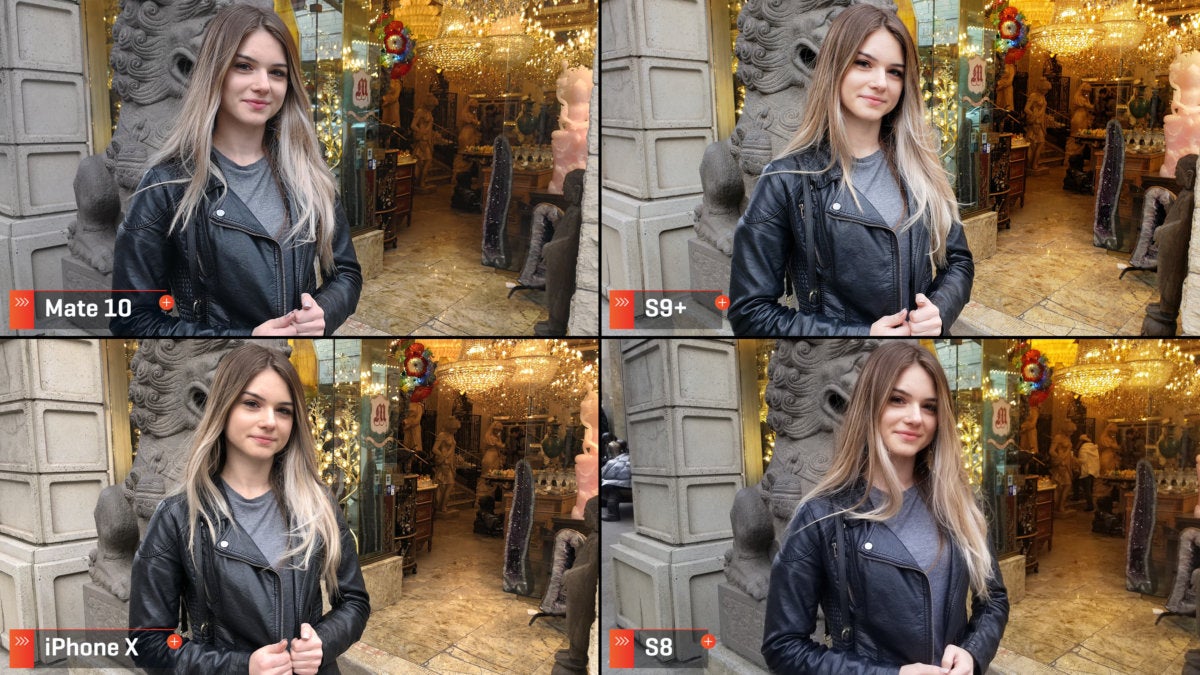 Adam Patrick Murray/IDG
Adam Patrick Murray/IDG This first dig with Victoria hanging out it in San Francisco's Chinatown plays out merely like we've seen in onetime tests. The Mate 10 is more desaturated and leans to the cooler face, piece the iPhone leans warmer and is same saturated. The S9+ is a bit closer to the Mate 10 than the S8, which surprisingly delivered the most innate color.
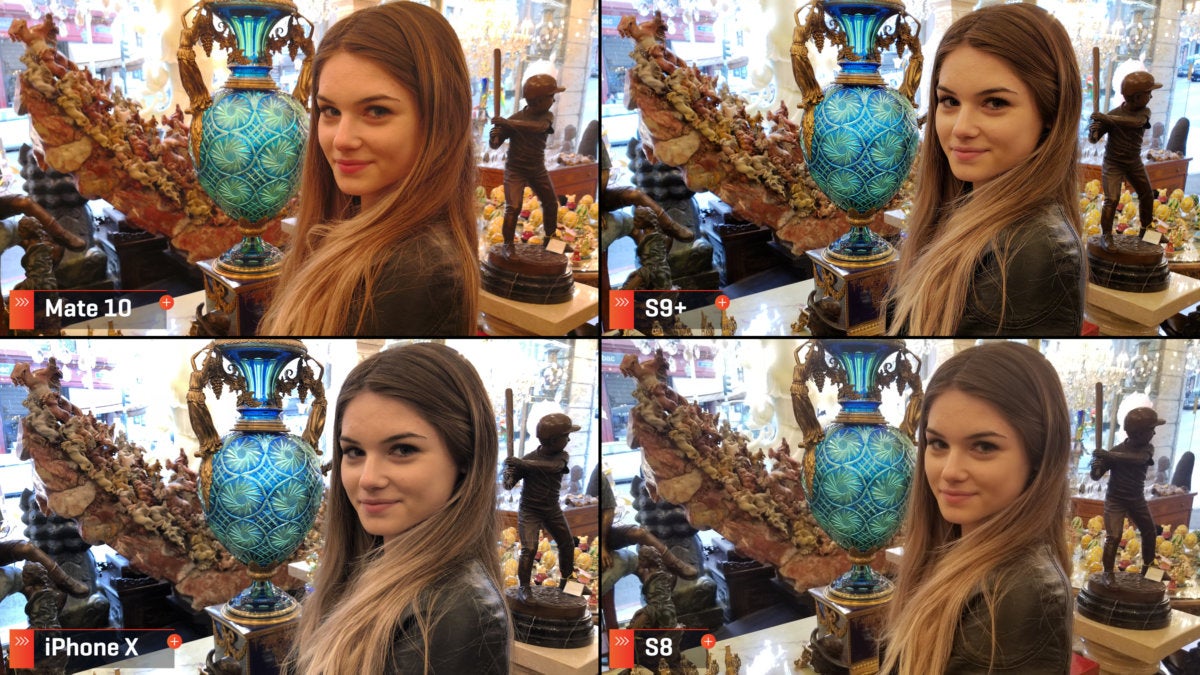 Go Patrick Murray/IDG
Go Patrick Murray/IDG Moving inside the store, and it's almost the diametric. The iPhone 10 is desaturated and counteracts the yellow lights first-rate. The Mate 10 inverted the manikin's hair red, while the S9+ produces a yellow hue complete her face.
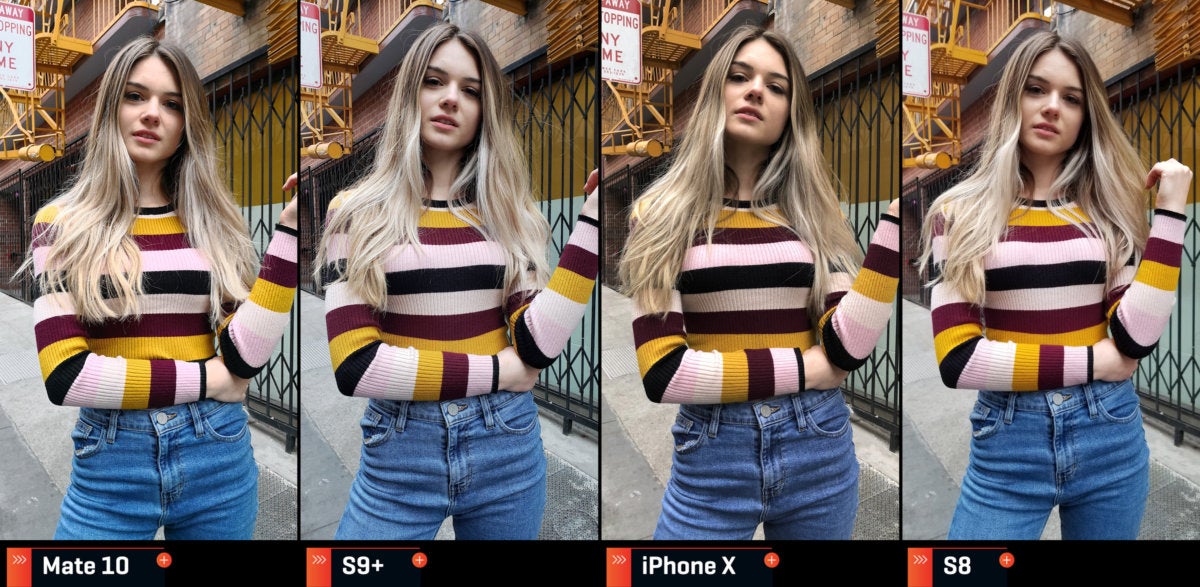 Go Patrick Murray/IDG
Go Patrick Murray/IDG Back happening the street, colour in reproduction is a little more even. In the photo supra, take the skin tones, the depressed jeans, and the fearful stripe on Victoria's shirt. The colors along the iPhone 10 are simply a little too oversaturated for my taste, while the S9+ is too cold. I'd personally go for the Mate 10 because it looks more natural to the eye.
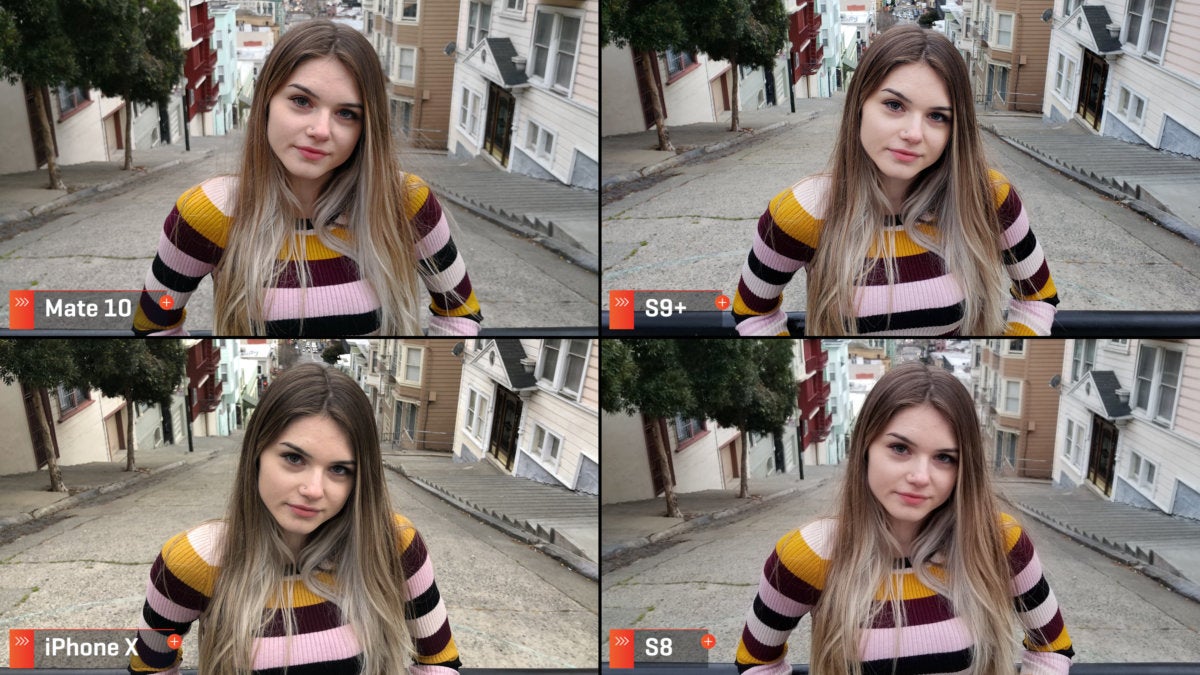 Adam Patrick James Murray/IDG
Adam Patrick James Murray/IDG Same matter in this shot above. The real is just too near on the iPhone and the Samsung phones are both a bit cooler than the Checkmate 10.
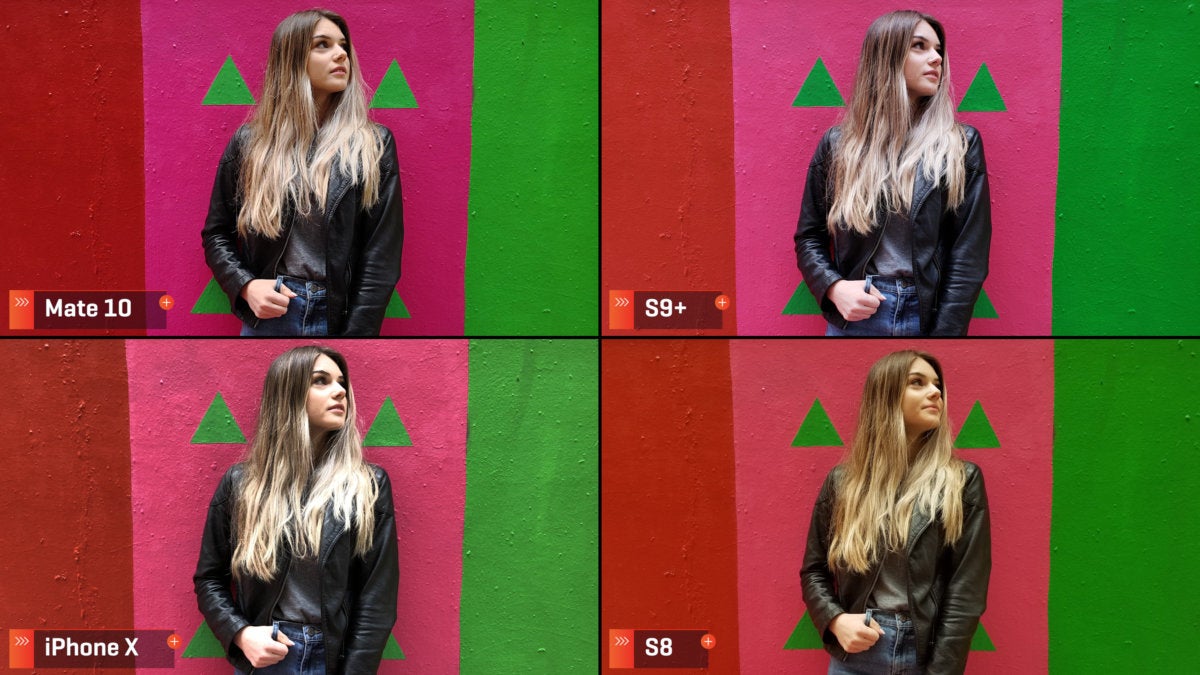 Adam Patrick Murray/IDG
Adam Patrick Murray/IDG Now this last shooting is really telling, and the results speak for themselves. The iPhone is oversaturated and blown out, while the S8 is very warm and muted. The Mate 10 and S9+ are pretty close, but the Mate has a much pleasing skin tone.
Overall, this color showdown is a proximate one and the S9+ keeps up, but the Mate 10 was more consistent in its white counterpoise readings, and didn't oversaturate images. So I'm giving the Color profits to the Huawei Mate 10 Pro.
Quiz Two: clarity
The second test category focuses connected clarity. Here we looking at the sharpness of for each one camera, and how fountainhead IT girdle sharp in dark environments. For the S9+ I'll notice the aperture value the phone choose to shoot in.
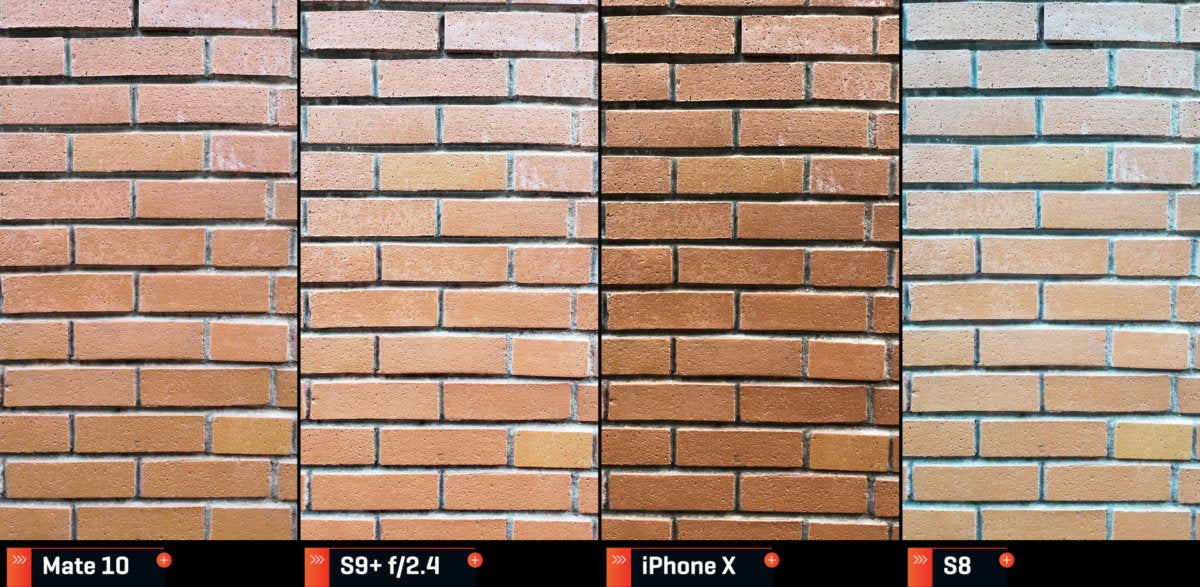 Adam St. Patrick Murray/IDG
Adam St. Patrick Murray/IDG Full size
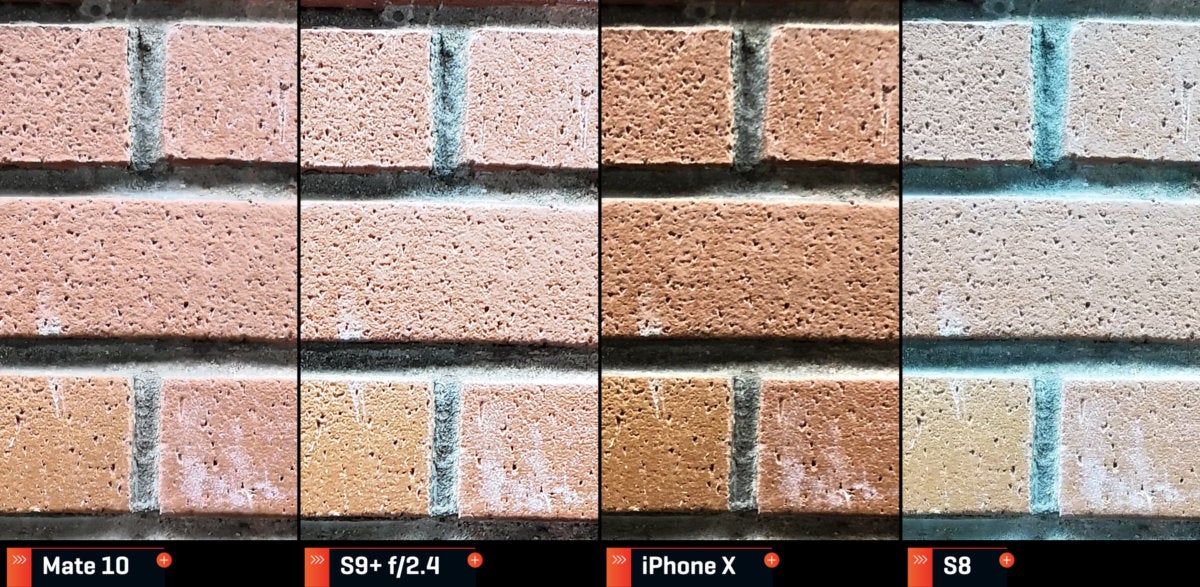 Adam Patrick Murray/IDG
Adam Patrick Murray/IDG Zoomed in
Showtime up is my go-to barb of a brick wall up. Zooming in reveals a massive amount of sharpening on the Samsung phones, only that's Samsung's trademark. Interestingly, the iPhone is soft around the edges, but the Mate 10 has the go-to-meeting texture here.
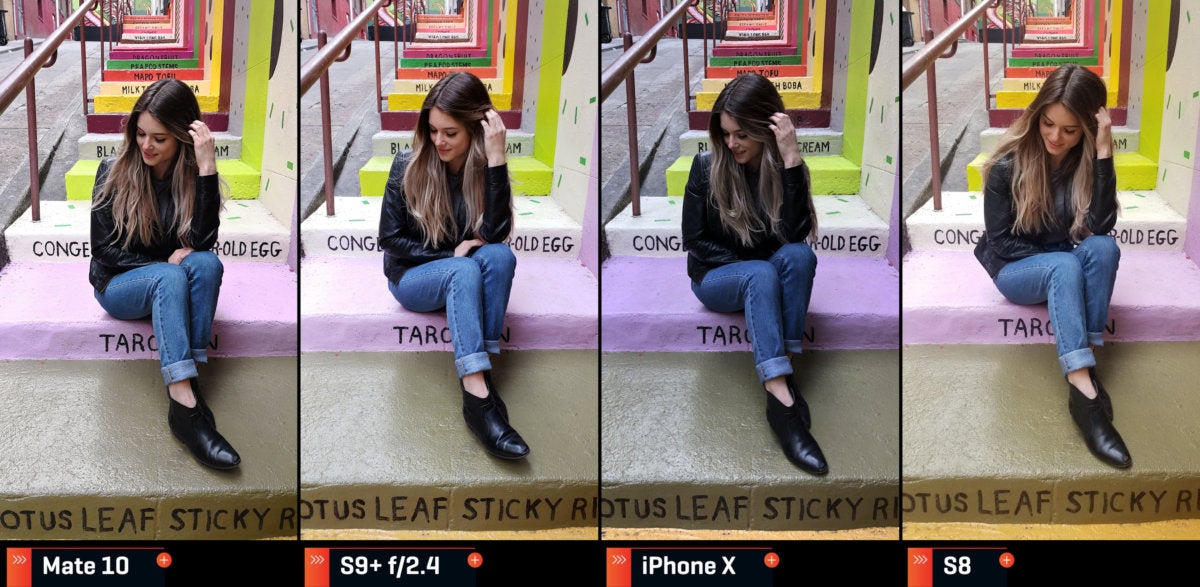 Adam Patrick Murray/IDG
Adam Patrick Murray/IDG 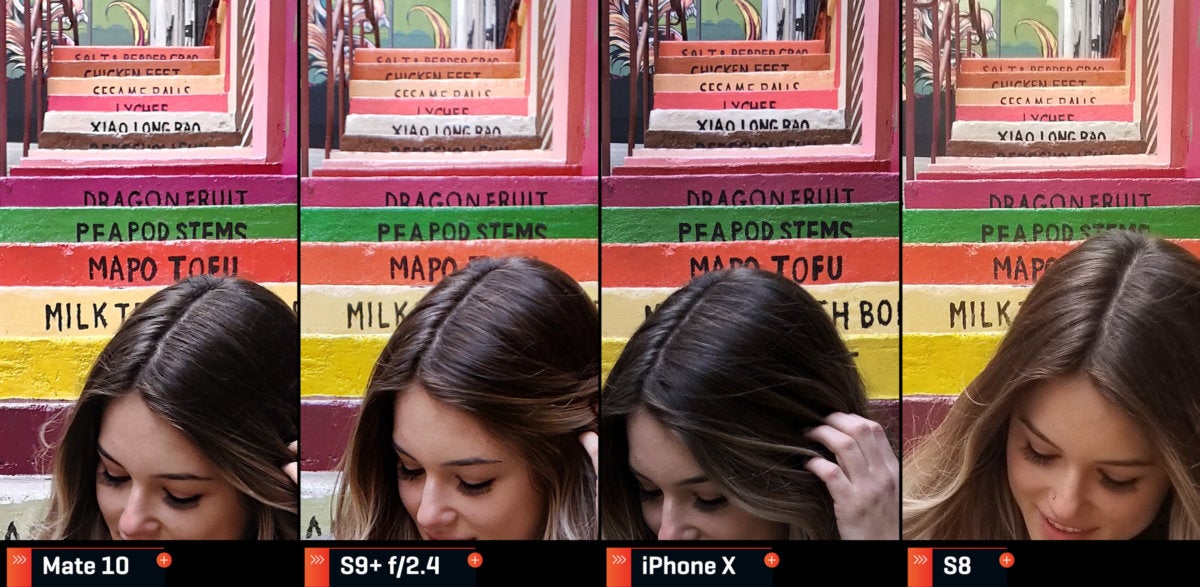 Cristal Patrick Murray/IDG
Cristal Patrick Murray/IDG Here on the stairs, I'm surprised by just how soft the letters are behind the model in the S9+ exposure. Samsung says the camera's aperture closes down to f/2.4 in order to stay put card sharp, which should theoretically be geographical. But at f/2.4, the phone should also be able to keep the object in the distance in focus. But that's just not the case.
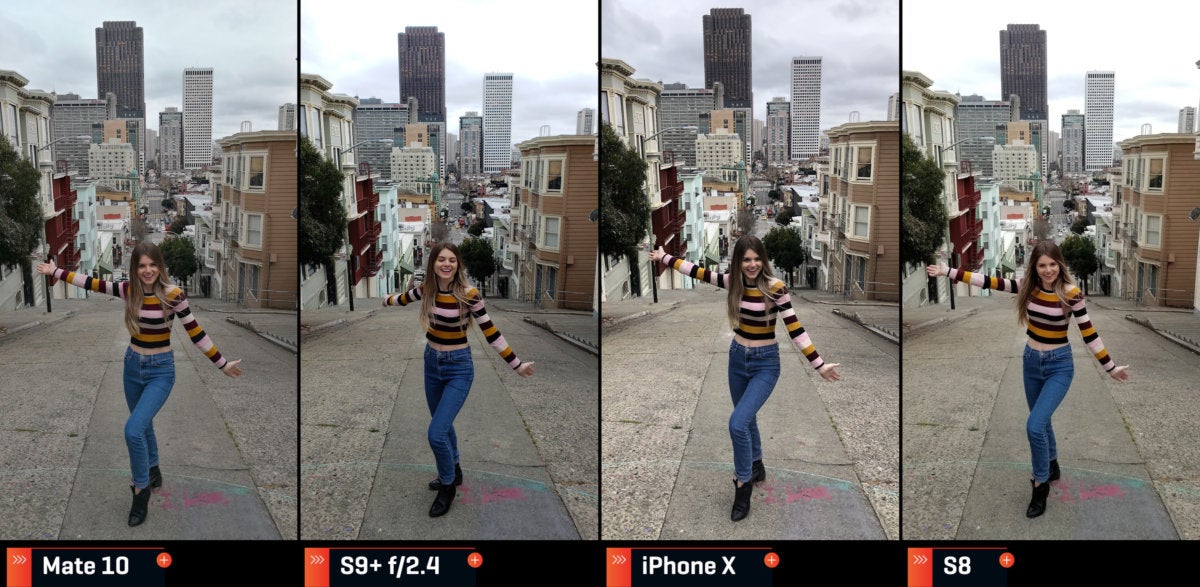 Adam Patrick Murray/IDG
Adam Patrick Murray/IDG  Cristal Patrick Murray/IDG
Cristal Patrick Murray/IDG Synoptic thing on this wide shot here: The Hilton ratify should be cardsharper than that when the S9+ is stopped downwardly. Then it got me thinking: Could f/1.5 follow even softer?
 Adam Patrick Murray/IDG
Adam Patrick Murray/IDG 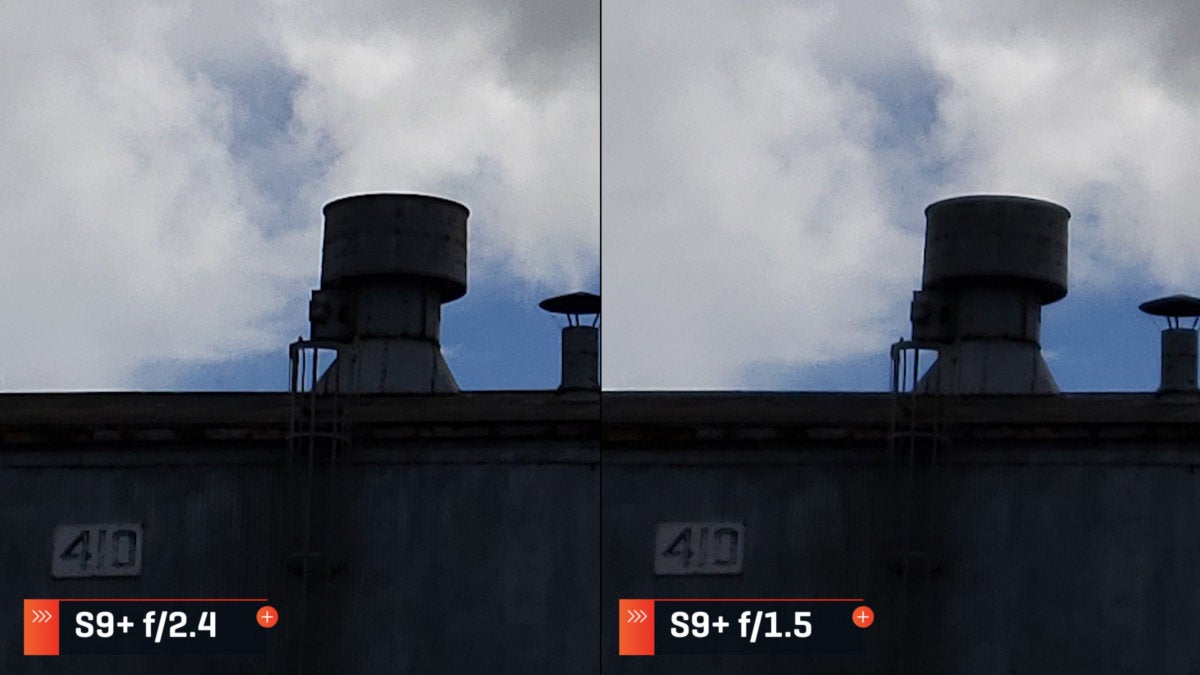 Adam Patrick Murray/IDG
Adam Patrick Murray/IDG Switching to manual mode along the S9 lets you manually on/off switch between f/1.5 and f/2.4. And shot after shot, I didn't insure a huge divergence in terms of sharpness between the two aperture values.
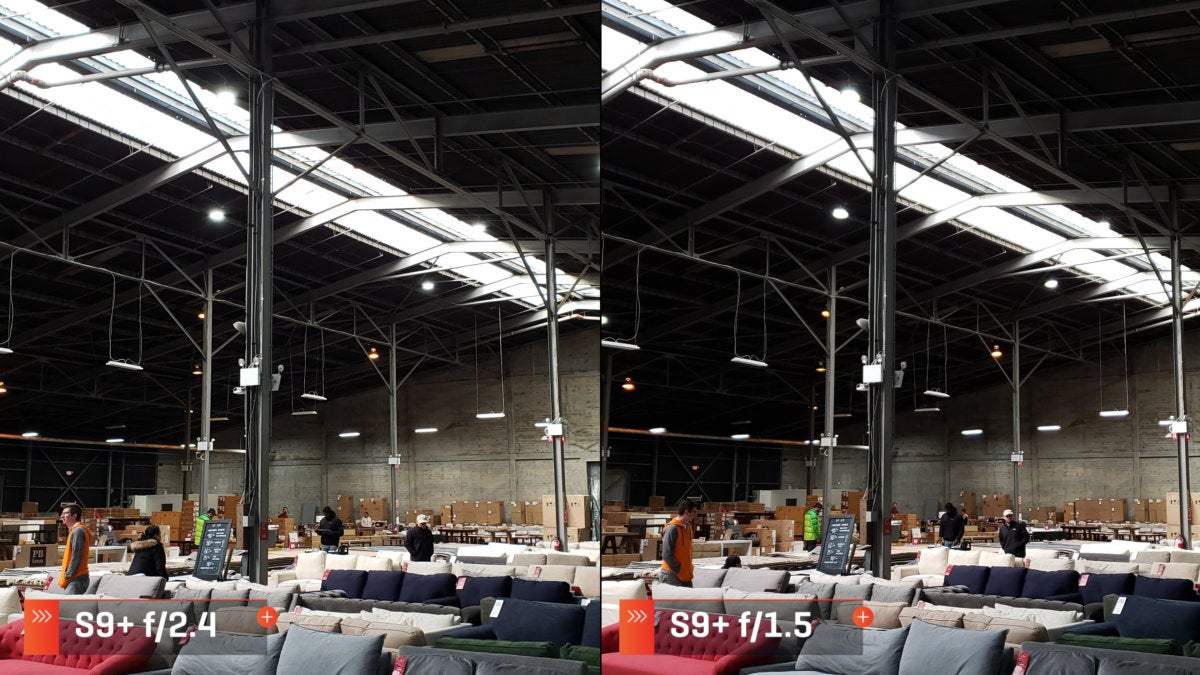 Adam Patrick Murray/IDG
Adam Patrick Murray/IDG 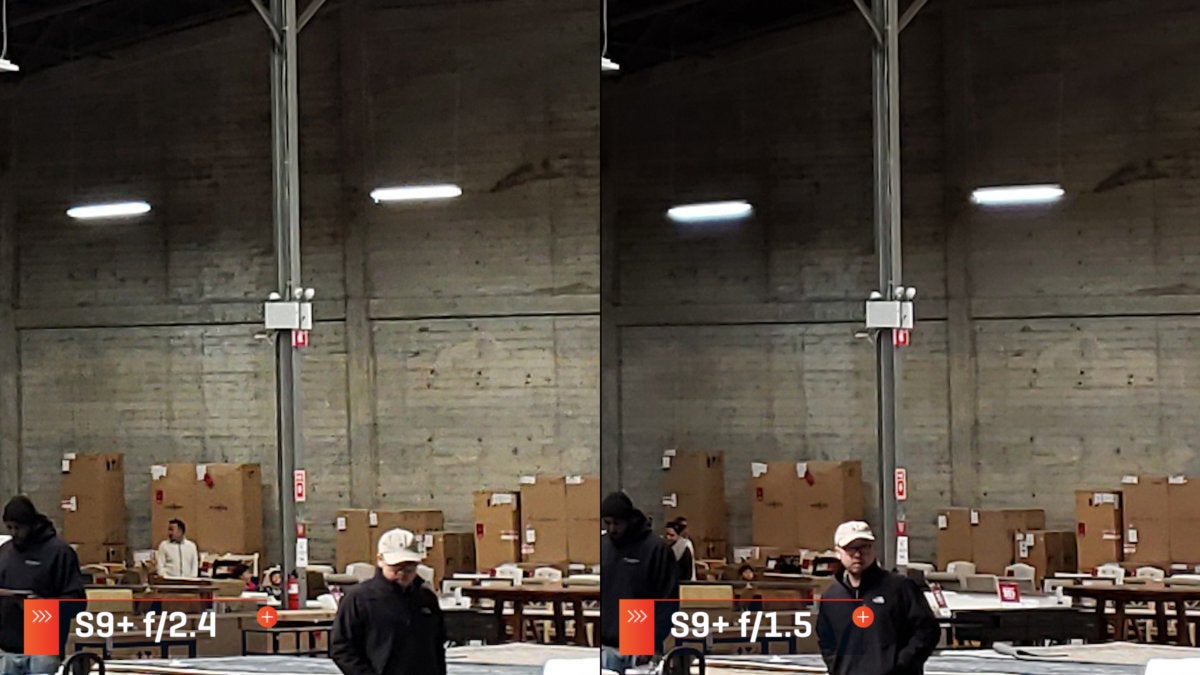 Adam Patrick Sir James Augustus Henry Murra/IDG
Adam Patrick Sir James Augustus Henry Murra/IDG If Samsung included multiple apertures so that the f/1.5 could help in low light while allowing the f/2.4 to maintain bite in bright light, then I'm not sighted IT.
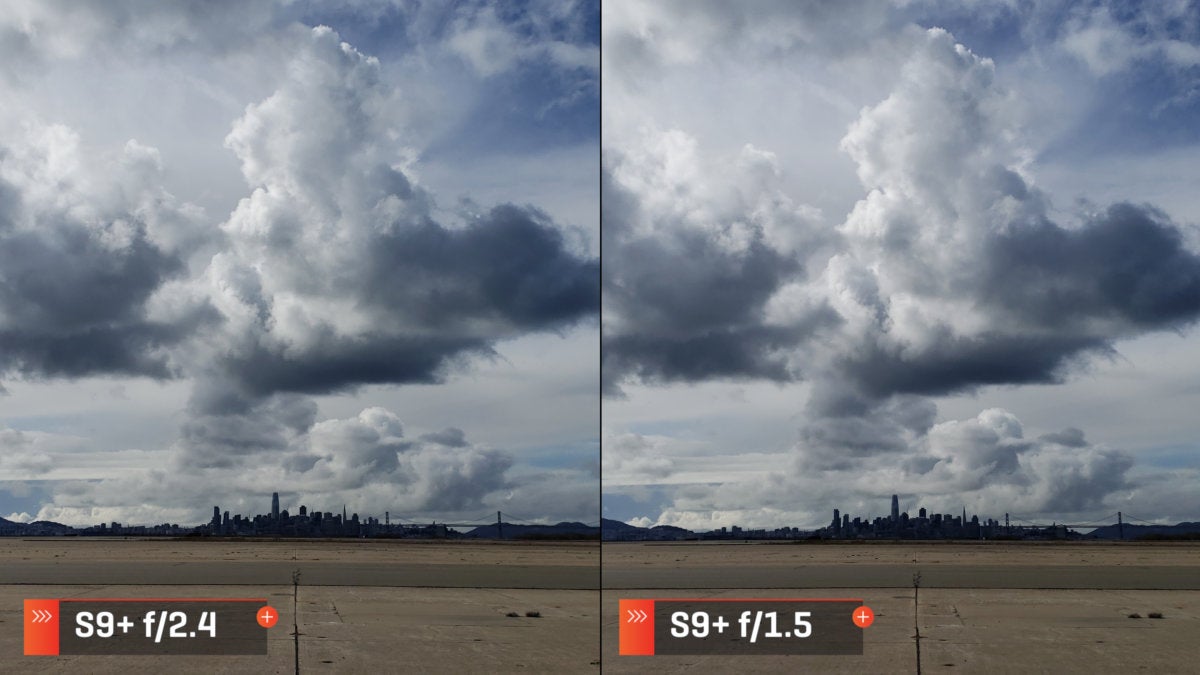 Adam Patrick Sir James Augustus Murray/IDG
Adam Patrick Sir James Augustus Murray/IDG 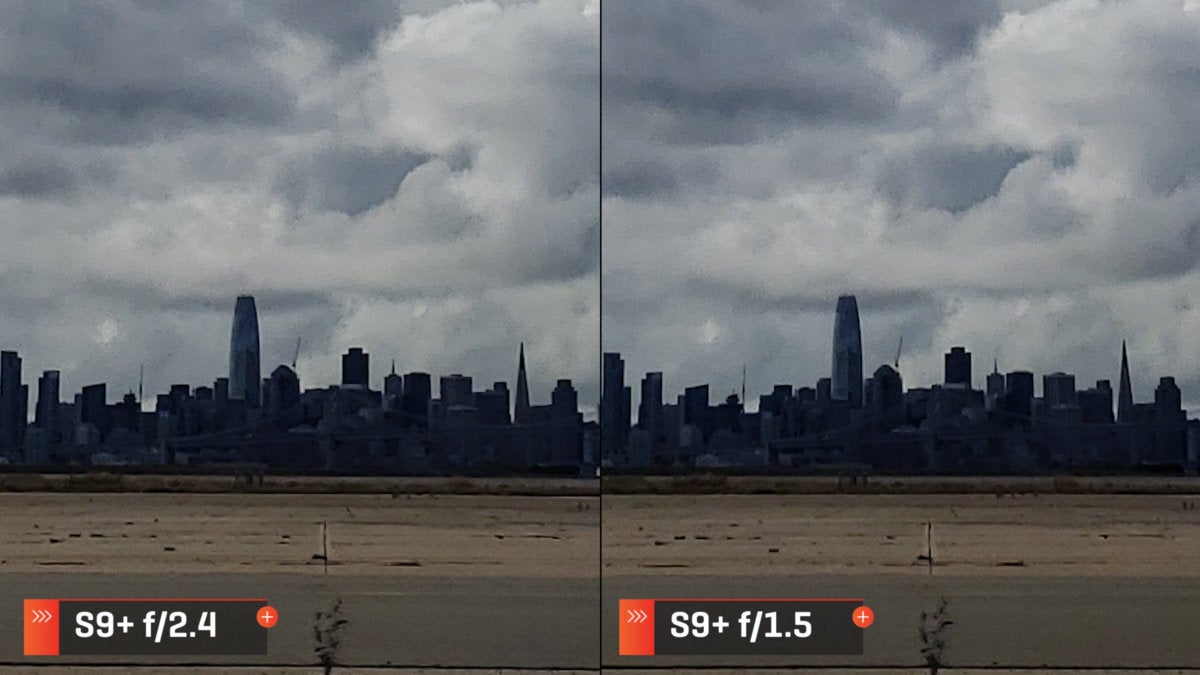 Adam Patrick Murray/IDG
Adam Patrick Murray/IDG As a matter of fact, for the most divide, I can't find a reason why Samsung couldn't righteous let the camera stay at f/1.5 and call it a sidereal day. This healthy "dual aperture" thing just doesn't bear extinct in real-populace results.
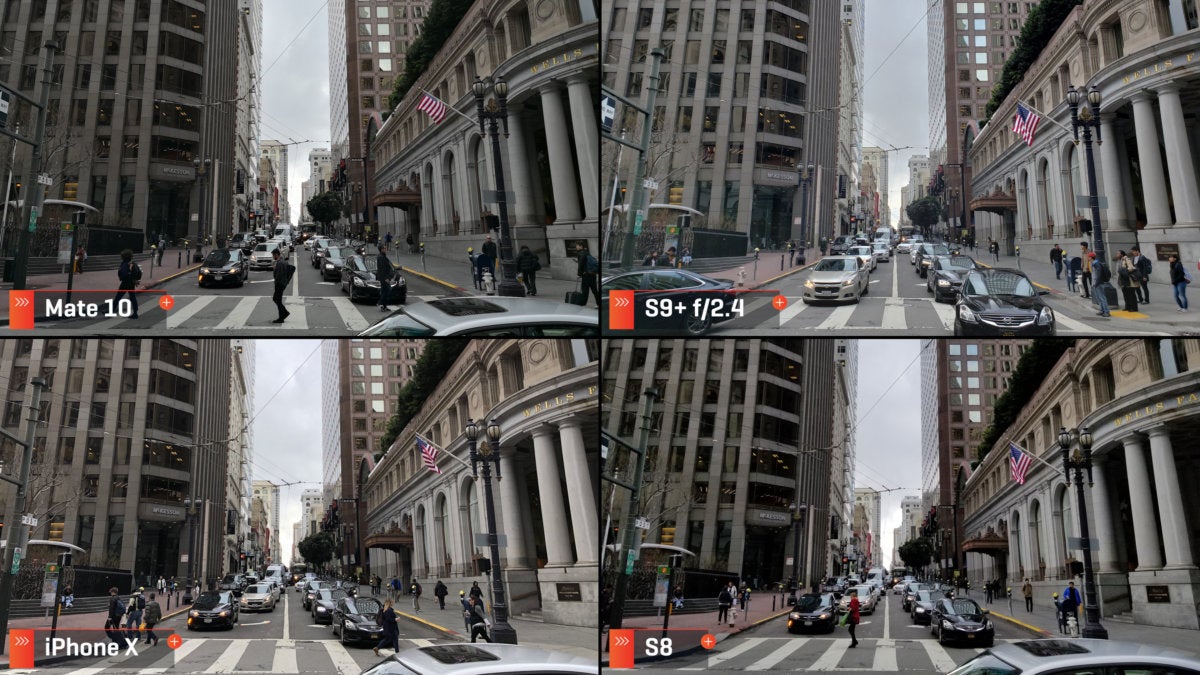 Adam Patrick Murray/IDG
Adam Patrick Murray/IDG 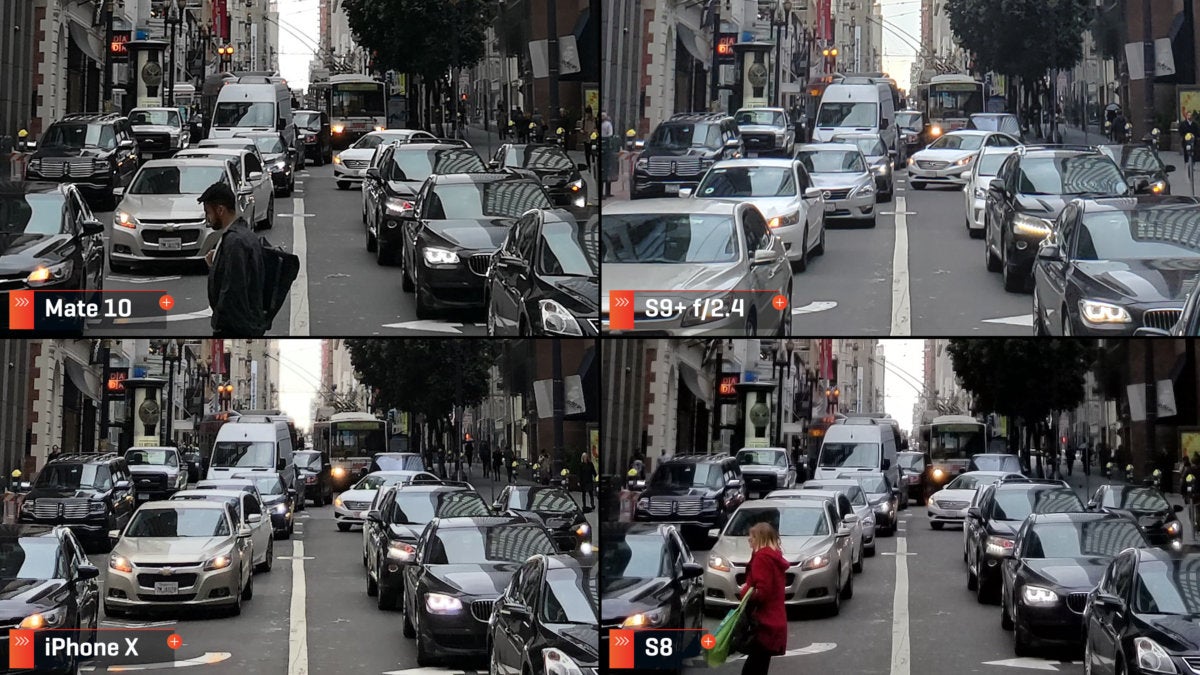 Adam St. Patrick Murray/IDG
Adam St. Patrick Murray/IDG So, back to the rest of the phones. In bright ignition scenarios, the Mate 10 has the sharpest images. Both Samsung phones exhibit a weird ghosting pattern around the cars here, which doesn't help clarity overall.
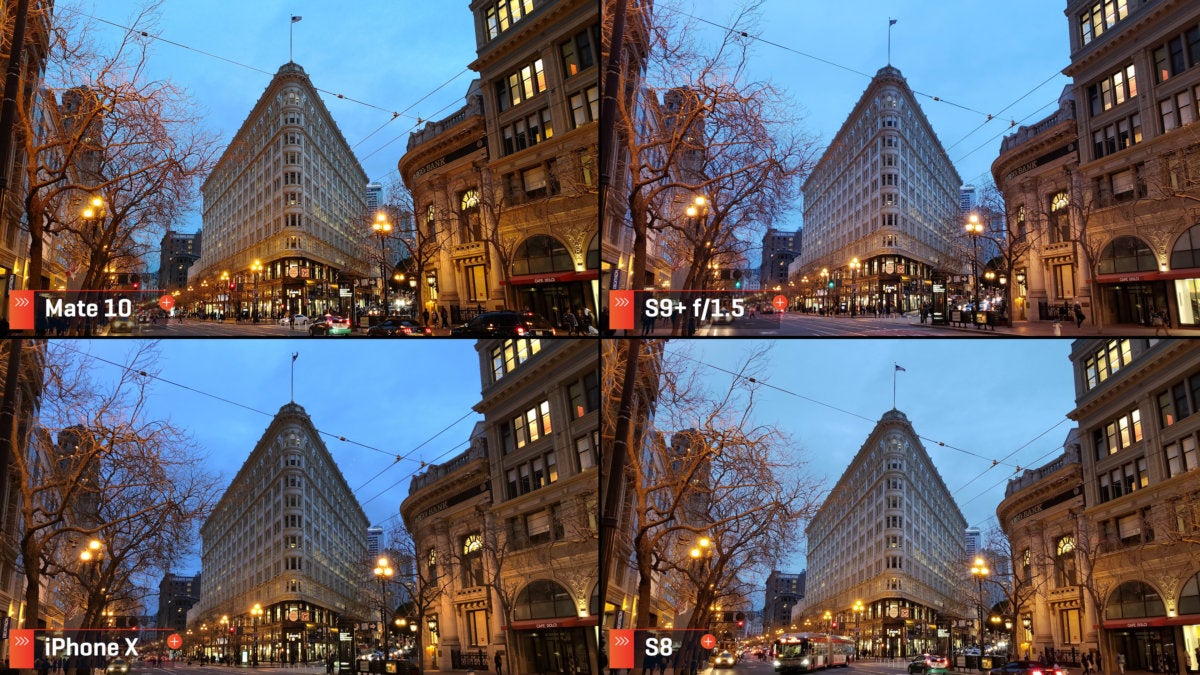 Go St. Patrick Murray/IDG
Go St. Patrick Murray/IDG 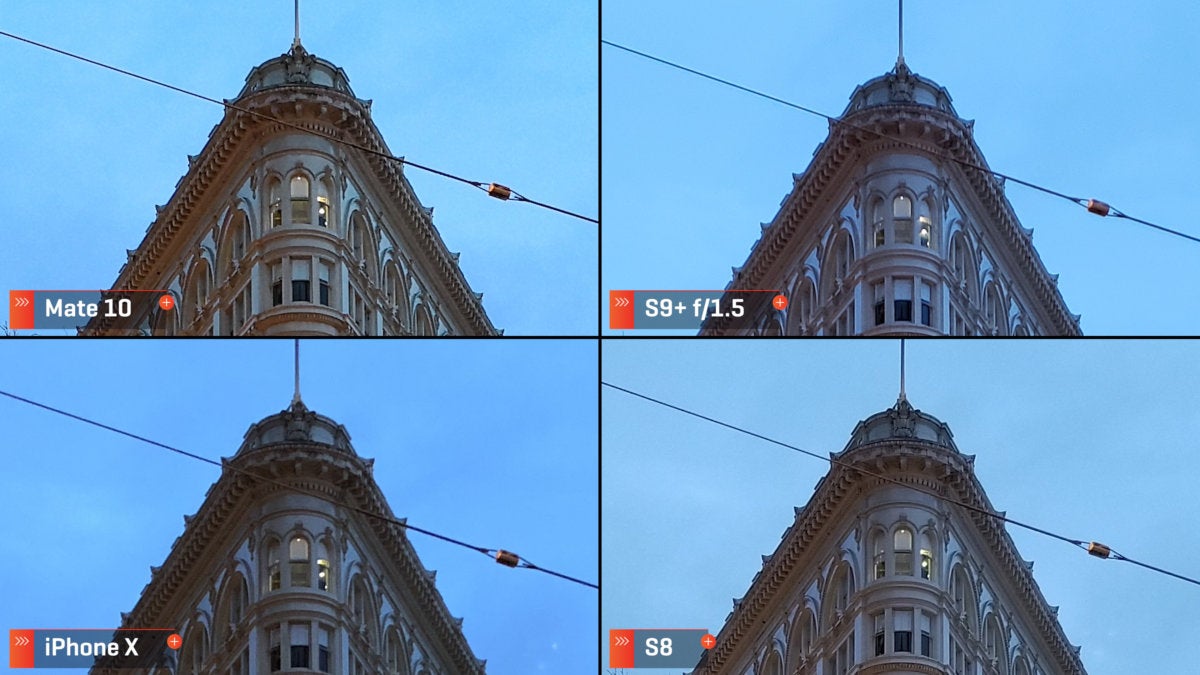 Adam Saint Patrick Murray/IDG
Adam Saint Patrick Murray/IDG Even at gloaming, this shot of a building is sharper on the Teammate 10, and at such great distances, the iPhone comes in indorse. Also, the S8 actually does better than the S9+ Here.
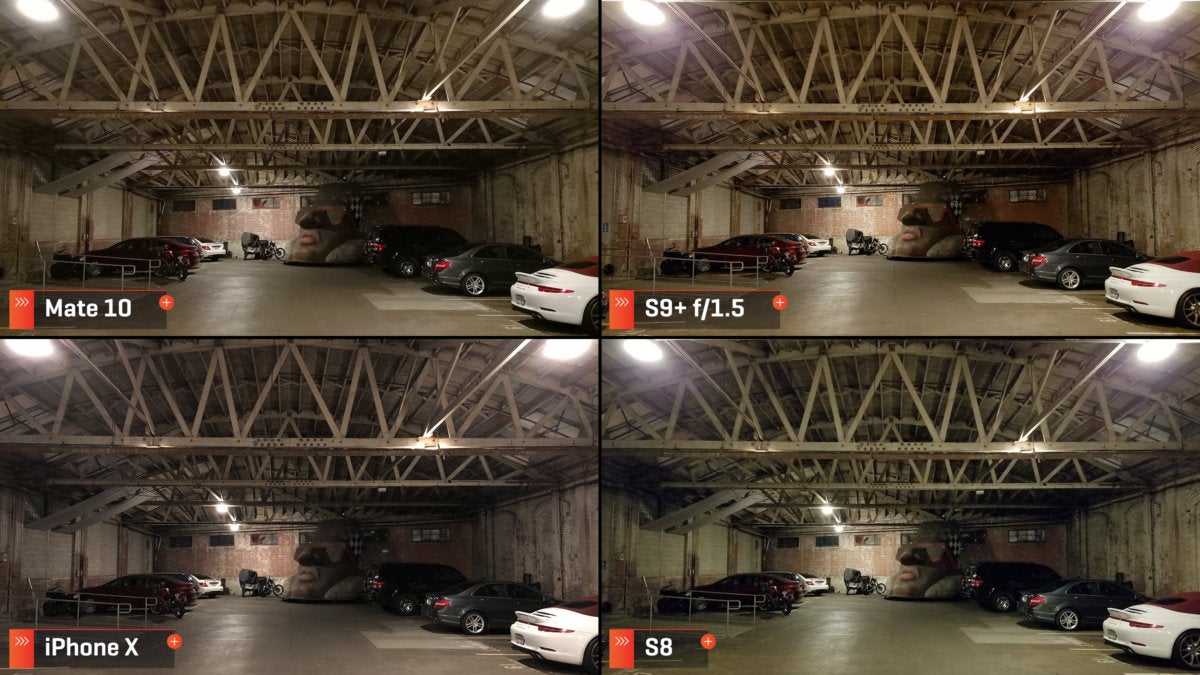 Adam Patrick Murray/IDG
Adam Patrick Murray/IDG 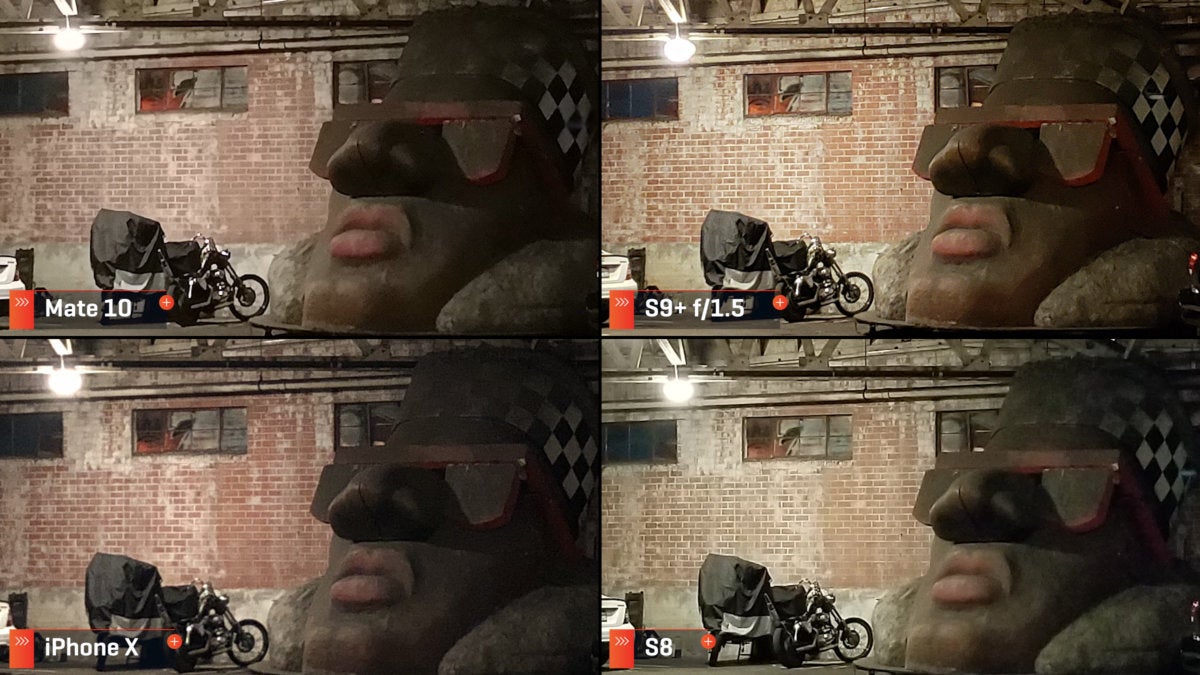 Adam Patrick Murray/IDG
Adam Patrick Murray/IDG Now we move into some very dark scenes to cheque low-light carrying out, because here is where Samsung shines. This wider shot is imposingly sharp on the S9+—just feel out the spokes thereon bike. The Mate 10 and iPhone sustain, and even the S8 does bad good.
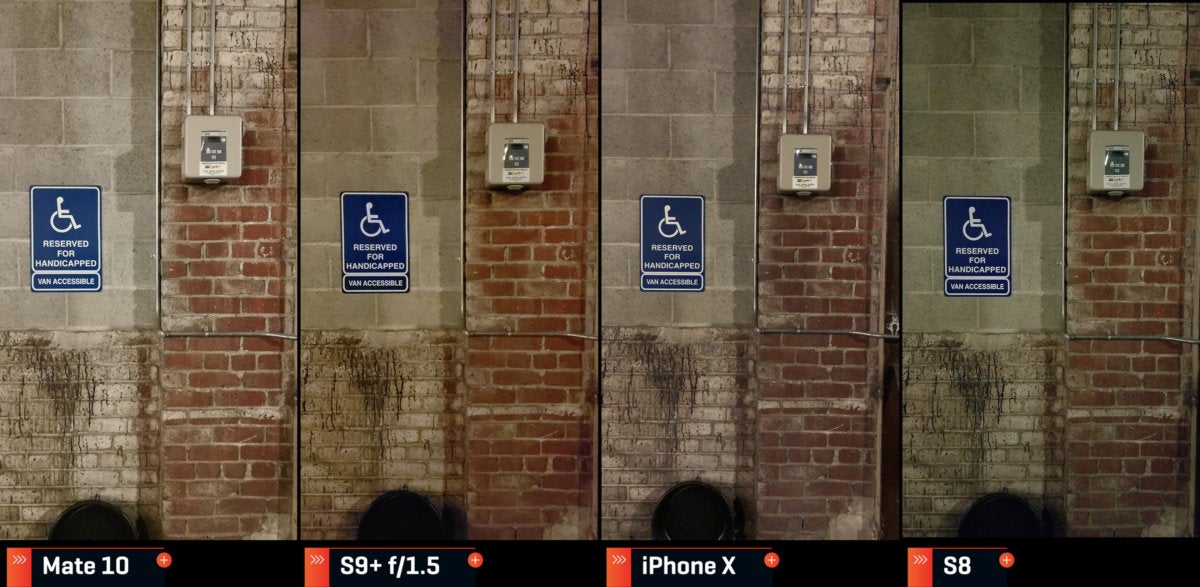 Go Patrick Murray/IDG
Go Patrick Murray/IDG 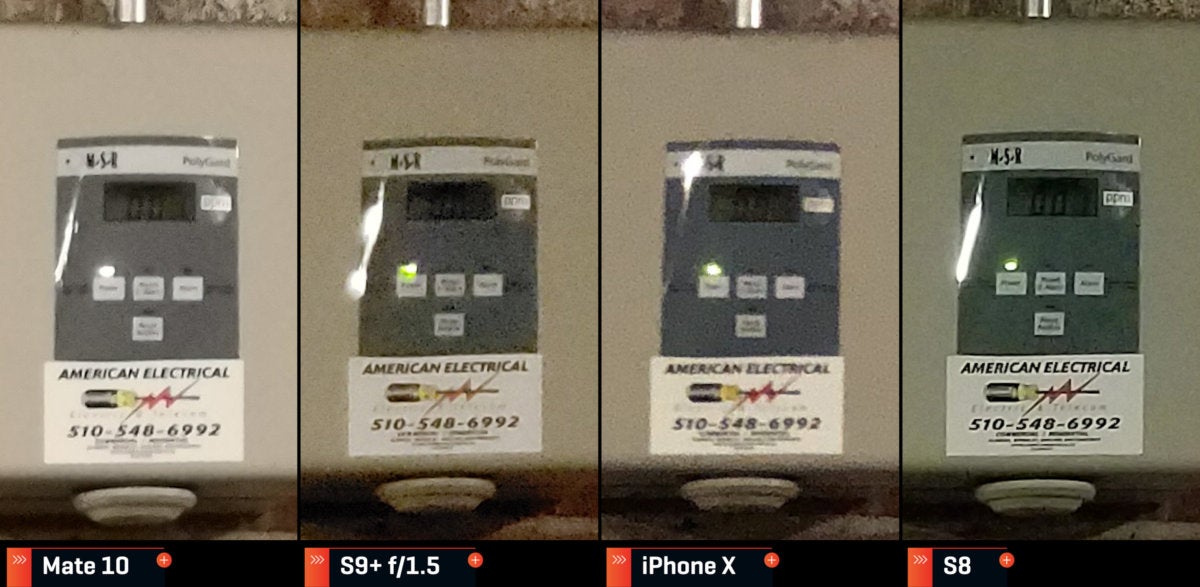 Ecstasy Patrick James Augustus Murray/IDG
Ecstasy Patrick James Augustus Murray/IDG Moving in a number closer to the wall, and we have a surprise! The S8 kills the S9+. In fact the Pair and iPhone are even clearer than the S9+ therein shot. So, while Samsung does roughly astounding things in low light, the S9+ is contradictory whereas the Mate 10 is solid throughout every lighting scenario. The Huawei Mate 10 Affirmative wins the clarity section American Samoa well.
Test Three: exposure
The third test category is exposure. In this one, we cover how the camera exposes for a scene, and find out equitable how untold dynamic chain of mountains is retained in the shot. I'll be including histograms in this section so you can equalise to a greater extent detail.
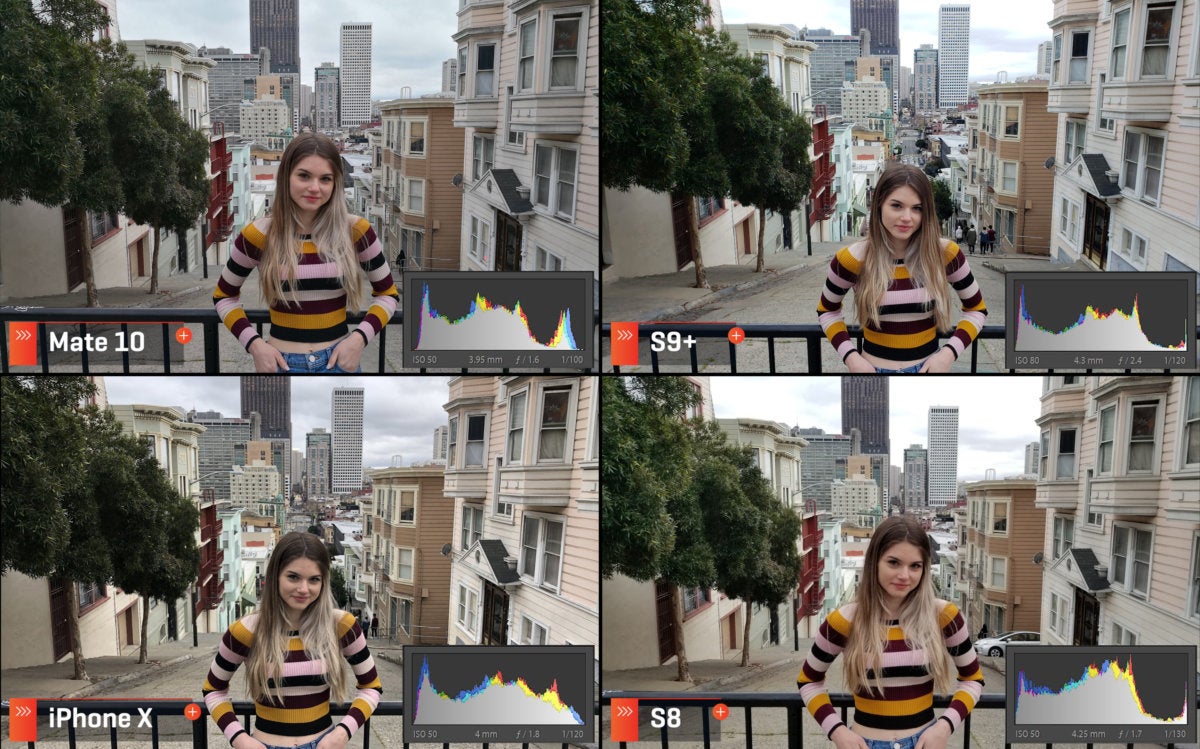 Hug dru Patrick Murray/IDG
Hug dru Patrick Murray/IDG Let's start with a squeamish city shot. The Mate 10 and iPhone 10 both capture a satisfying photo and retain plenty of information in the extreme ends of the histogram. Simply the S9+ and S8 both overexpose the sky, losing some haze over detail and color.
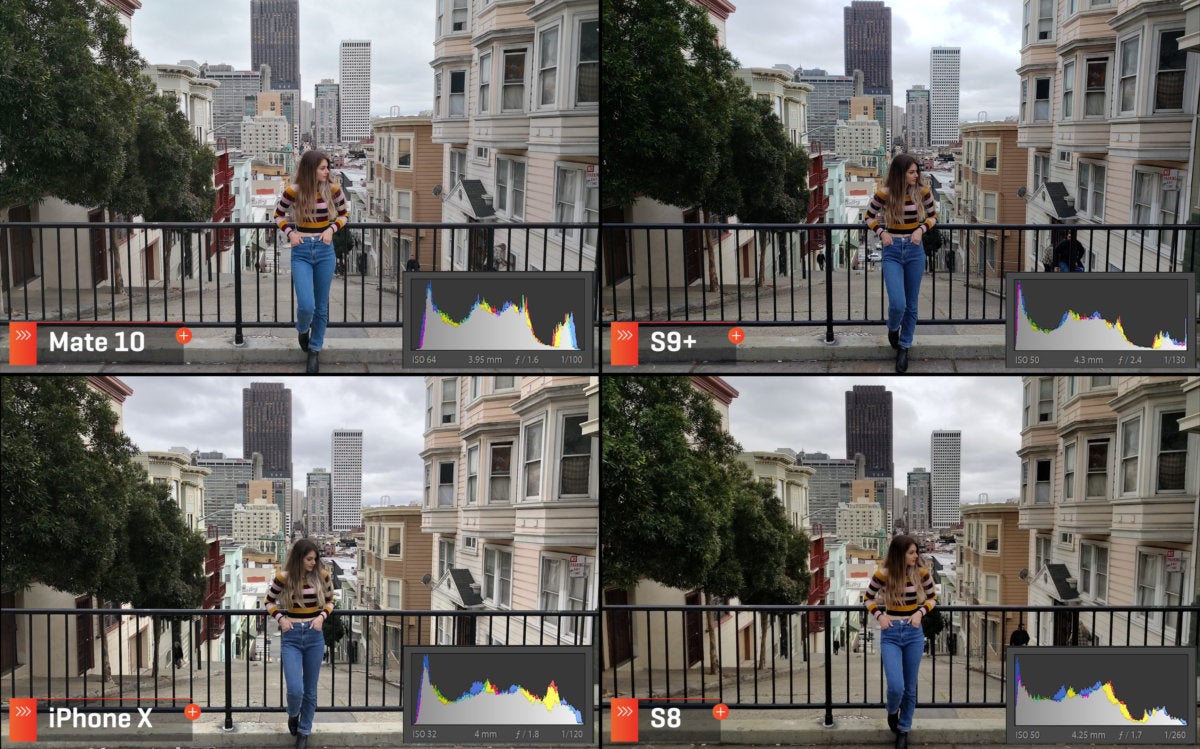 Adam Patrick Murray/IDG
Adam Patrick Murray/IDG Same thing happens here: The sky is dyspnoeal out happening the S9+. The shot along the Mate 10 is blandish, but if I was to edit these photos I'd rather add contrast into the shot than try to postulate it prohibited.
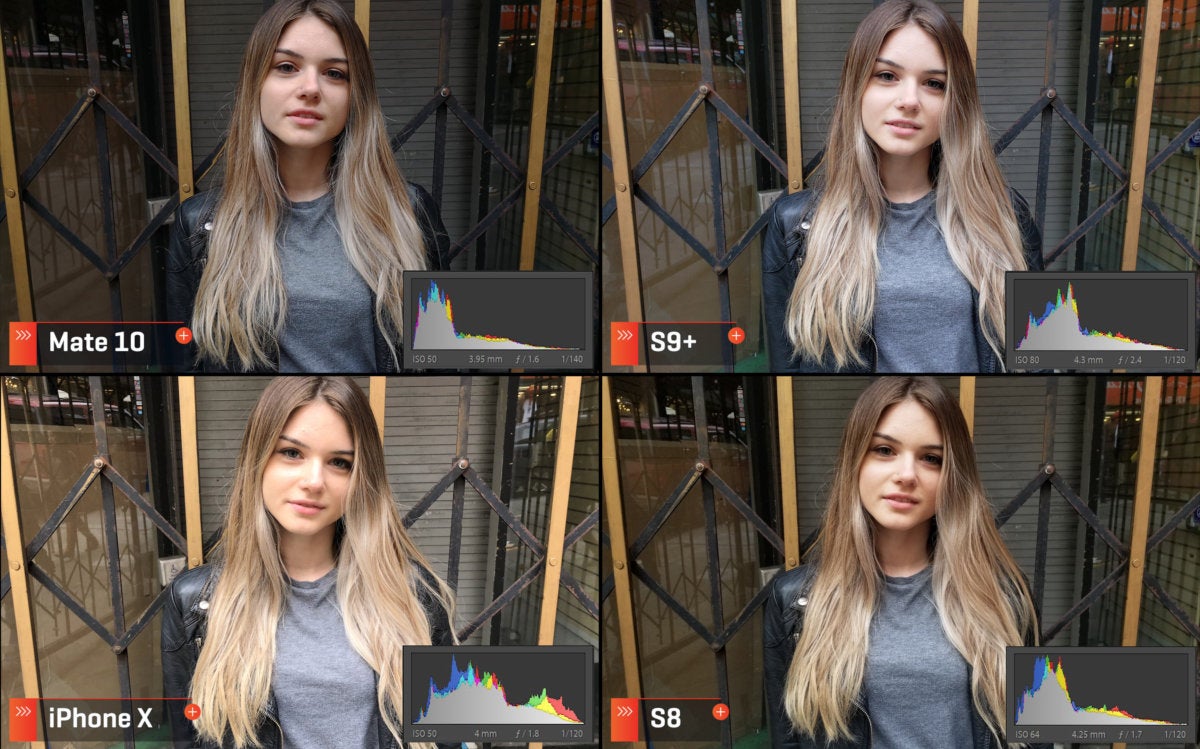 Adam Patrick Sir James Augustus Henry Murra/IDG
Adam Patrick Sir James Augustus Henry Murra/IDG Just here the S9+ does better. The Mate 10 is a bit underexposed, and the skin on the example in the iPhone shot is short-winded out. The S8 is on the darker root, retributory like the Mate 10.
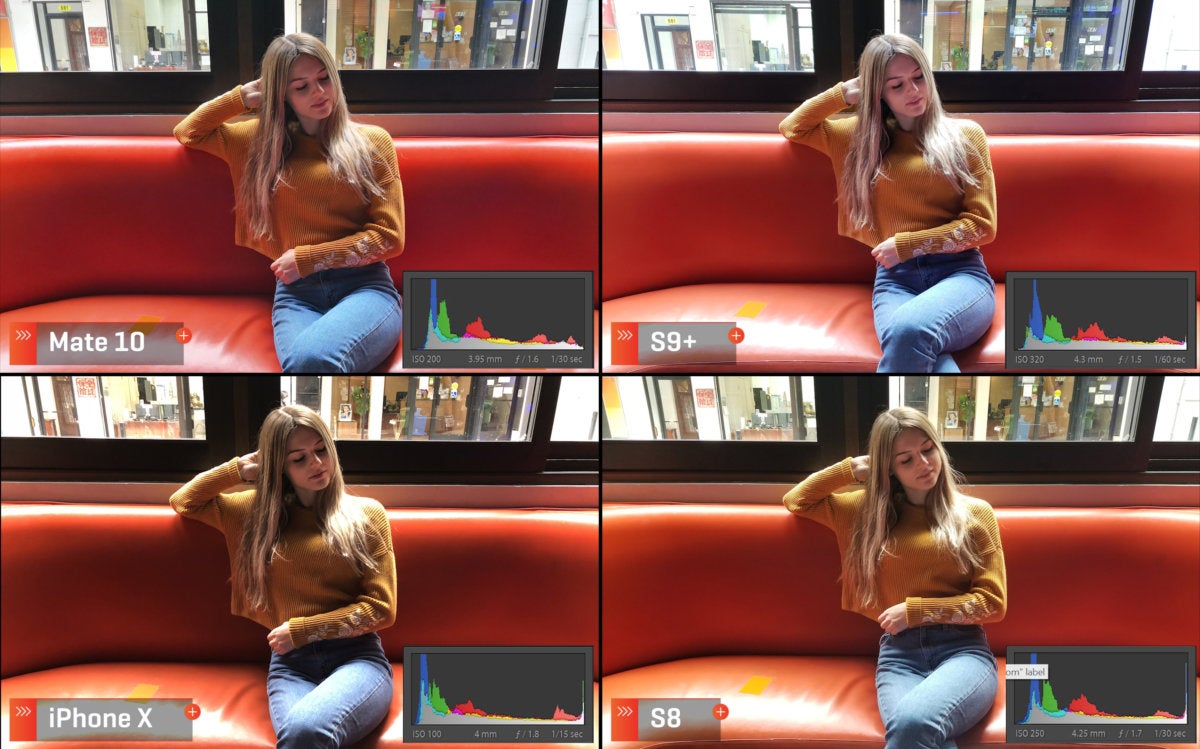 Adam Patrick Murray/IDG
Adam Patrick Murray/IDG This next shot should reveal how the cameras handle backlit scenarios. Every speech sound other than the Mate 10 blows impermissible the highlights on the red bench and White wall up the background knowledge. Focusing just on the face, the Mate 10 also feels the most natural and evenly unclothed.
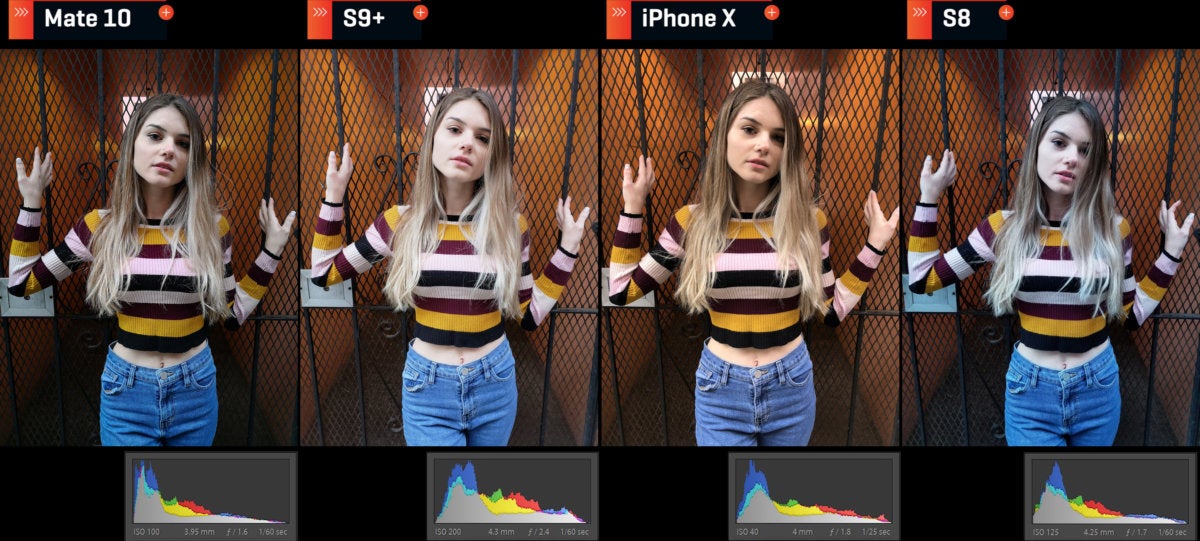 Adam Patrick Sir James Augustus Henry Murra/IDG
Adam Patrick Sir James Augustus Henry Murra/IDG In this maiden alleyway dig, Victoria looks ghostly on the S9+. She's non unfortunate in the Partner 10 shot, merely I actually prefer the iPhone photograph here. It's a more symmetric exposure patc quieten delivering roughly depth in the shadows.
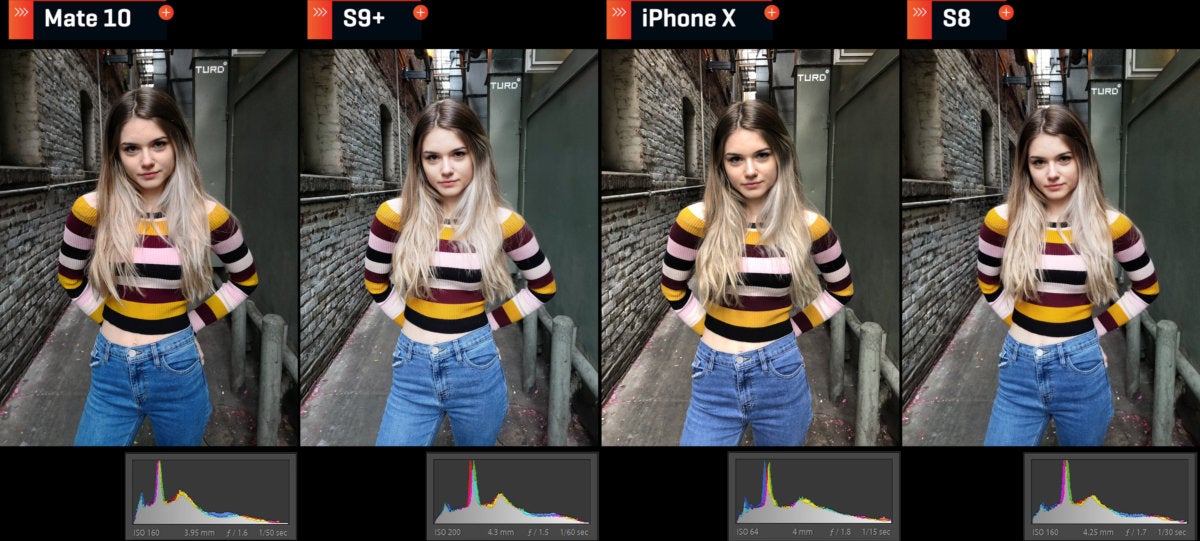 Adam Patrick Murray/IDG
Adam Patrick Murray/IDG This last photo has the S9+ once again exposing the example's skin too brightly. It's a fine line between having a punchy image with contrast that adds depth and retaining information in the exposure, but the iPhone feels excessively processed here, so I'm going with the Mate 10's shot.
 Adam Patrick Murray/IDG
Adam Patrick Murray/IDG Both Samsung phones baffled information from overexposure in as well many scenarios, and the iPhone tended to burn out skin tones. The Mate 10 underexposed in some scenarios, but didn't loose anything that couldn't be brought dorsum in editing. So, Huawei's Pair 10 Pro goes three for three, taking the exposure category.
Examination Four: user live
The fourth and concluding test category looks at user experience. Hither I get into what it's like to use the photographic camera day to day, and work my attending to special features in the camera apps.
We'll start with the Mate 10. IT has a fast and powerful tv camera app, but it's not the most substance abuser friendly. Trying to find the Favoring mode isn't selfsame unambiguous, and unfortunately that continues through the rest of the app's menu features.
But Huawei does have an amazing monochrome mode, using a secondary 20 megapixel sensor. Cap that soured with Huawei's AI-powered scene and objective recognition, and you receive a great and reliable user undergo.
For the S9+, Samsung has redone its app layout to something that iPhone users will agnize. It's jolly straightforward and impressionable to use, and has a fun AR Emoji option well-stacked powerful in. But I had a duet of problems using the S9+ app daily. First off, I set up switching 'tween modes to be very slow. As I was examination out Dual Aperture in blue-collar mode, I was dreading trying to to puzzle over there time and again again from auto musical mode. So there's Bixby Vision, which always pesters you in auto mode, and military man, is that frustrating.
The iPhone X is fast and easy to employment, but I don't corresponding how prolonged it takes to launch the camera. Connected all the early phones, you can launch the photographic camera app with a duple press of a button, which is something I can coiffure before even looking at the phone. The iPhone X, on the other hand, makes you raise the phone, then lasting push on the photographic camera icon to launch. That's too slow for me. But, over again, Apple's television camera app is decidedly the most easy to use erstwhile you're wrong information technology.
And finally we have the Samsung Galaxy S8. This phone has been knocked out for a year nowadays, so it's a acknowledged quantity at this point, but it delivers a self-colored experience withal. My biggest pain point while victimisation the S8 is the lack of a endorse lens for doing amusing things like Portrait Mode.
Oral presentation of Portraiture Modes, I did do some quick testing betwixt the three phones that have it, and I didn't find any huge improvements to the edge detection.
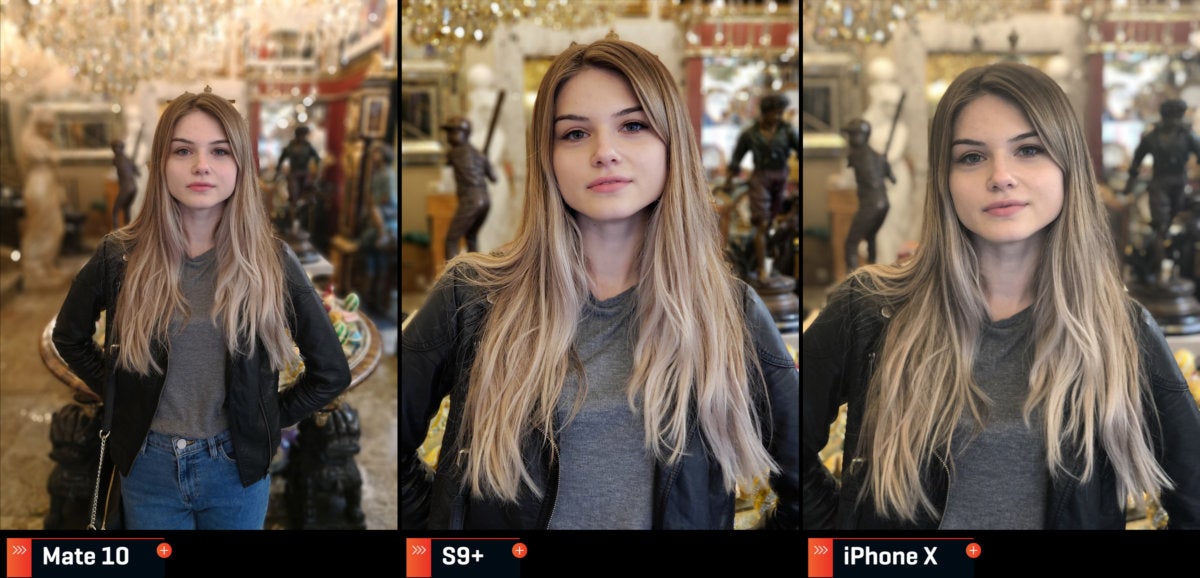 Adam Patrick Murray/IDG
Adam Patrick Murray/IDG 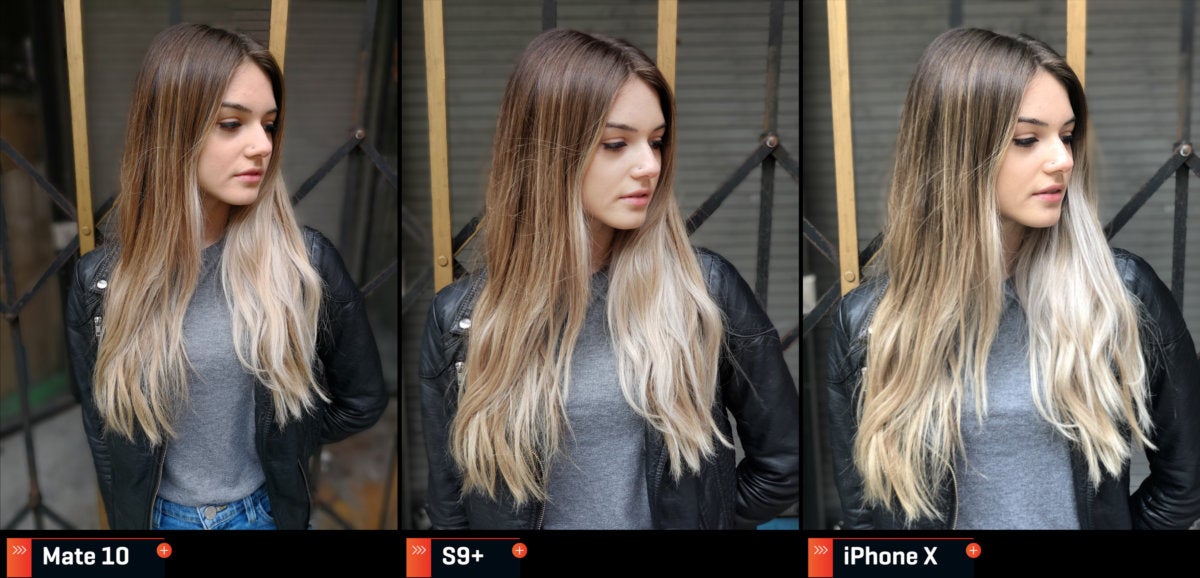 Adam Patrick Murray/IDG
Adam Patrick Murray/IDG 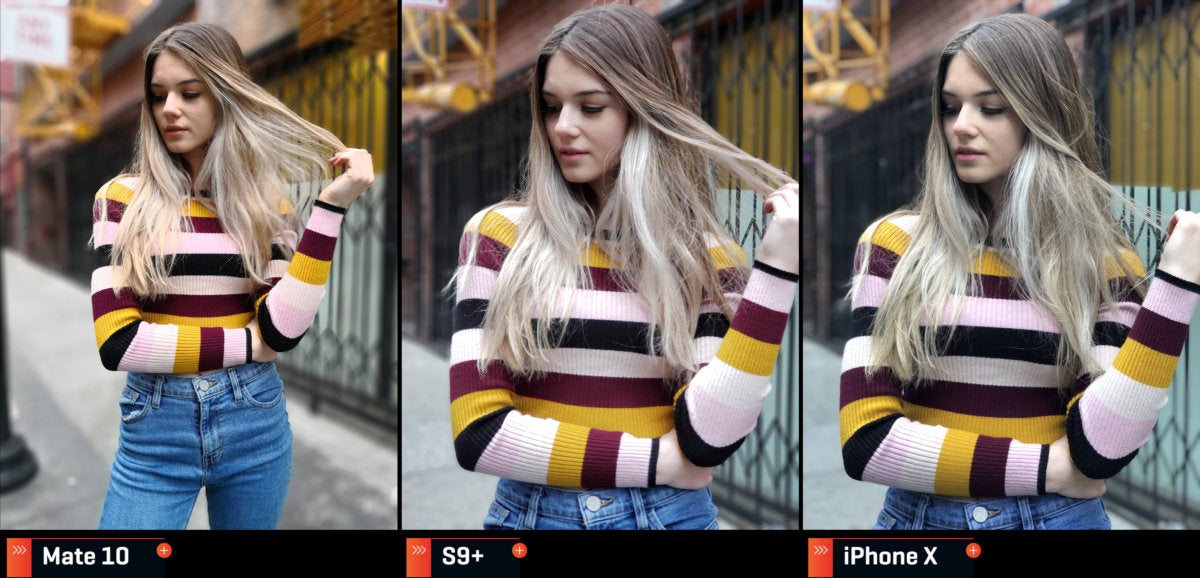 Adam Patrick Murray/IDG
Adam Patrick Murray/IDG I allay use these portrait modes all the time, but can't wait for further advancements in the tech. I lean toward the Mate 10 In favour of, with IT's wider domain of view, but each pick has information technology's problems separating foreground content from background capacity.
At any rate, at the end of the mean solar day I continued to love using Huawei's Mate 10 Pro, which takes the user experience category with a ton of advanced features.
And we have a success…
So to close information technology out, let's crown a winner. The S8 is still a real good camera that excels in humbled light, but it's been surpassed past the S9+ in almost every way. And piece the iPhone X keeps up with the pack, it wasn't able to win a rematch.
The Galaxy S9+ is Samsung's best camera up to now, just reinforces Samsung's habit of oversharpening and blowing knocked out highlights. And because the Dual Aperture approach doesn't deliver substantive improvements, I'm career the S9+ camera an evolution, not a revolution. (Yes, the new AR Emoji feature film is cool, and we give it props in our critical review of the entire earpiece, but IT doesn't have any bearing along actual camera carrying into action, which is what we'Re evaluating hither.)
Soh, victorious four out of four categories, and continued its reign is Huawei's Mate 10 Affirmative.
The Mate 10 Pro has been a good time to shoot with over the last couple months. It's a huge improvement over the Ilex paraguariensis 9 that came before IT, building bump off of the persuasiveness of Huawei's unique two camera arrangement. Add on top of that the Leica partnership and impressive Army Intelligence algorithms, and you suffer a camera system that might stay in the top spot for a while.
In its future smartphones, I'd love to see Samsung Be less agressive in its processing, specifically when it comes to sharpening and dynamic roll. Likewise, the Treble Aperture feature inevitably to deliver more tangible results. Information technology's an heroic feat of engineering, but I don't see any hard evidence that f/2.4 is that very much sharper than f/1.5, and low-scant performance is great, but non subverter.
Either way, the S9 family has some of the primo cameras out there. And even though it didn't beat the Huawei Mate 10 Pro in our testing, you hindquarters still get world-class images from it.
Source: https://www.pcworld.com/article/401660/samsung-galaxy-s9-camera-test.html
Posted by: bainpenit1972.blogspot.com


0 Response to "Samsung Galaxy S9+ camera test: How it compares against the rest - bainpenit1972"
Post a Comment